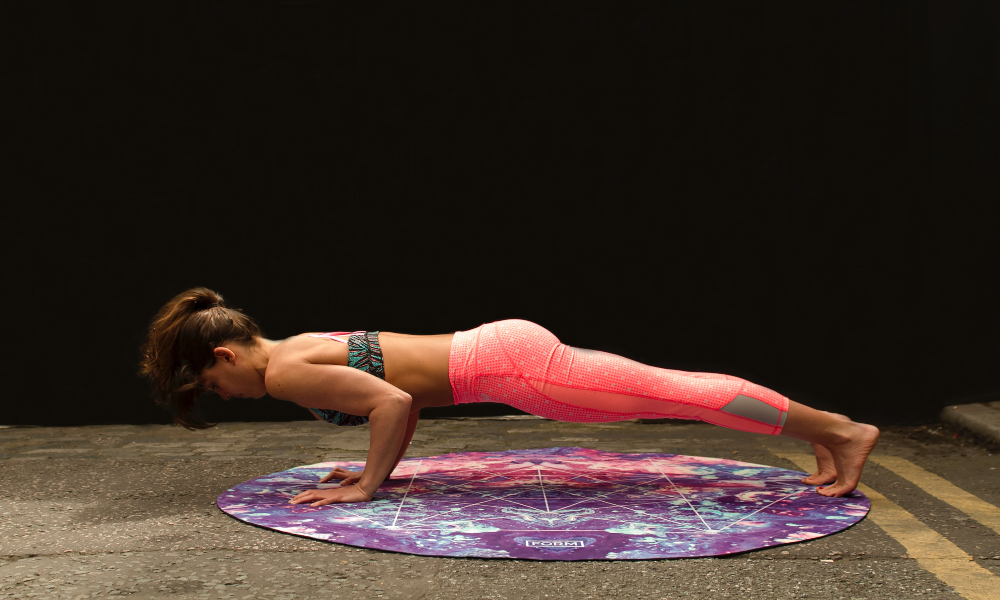Finding your rhythm to achieve the work exercise balance
By Lynn Bentley

Photo by Stage 7 Photography
Do you find daily exercise a constant struggle as it’s often the first priority to get scratched as you juggle a myriad of deadlines at work and at home? Maybe you find yourself becoming frustrated midweek, as yet again you’ve watched your carefully scheduled gym sessions disappear, making that gym membership fee seem a waste of your hard-earned salary? Or perhaps your job is so unpredictable and hectic that it’s just too difficult to maintain a sustainable exercise plan?
However, you’re trying to navigate your work exercise balance, this is hopefully a helpful guide to keep you on track and start you on your way towards making exercise a daily and rewarding priority in your life.
Let’s talk about your physical and mental wellbeing for a moment. I’m sure you are aware of the benefits of daily exercise, but here is an important quick reminder…
Regular exercise reduces the risk of major illnesses, such as heart disease, stroke, type 2 diabetes and cancer by up to 50% and lowers your risk of early death by up to 30%. (NHS) Exercising regularly is not only good for your physical health it is also good for your mind. It can reduce your risk of developing depression or dementia by up to 30% while maintaining a healthy lifestyle and balanced diet. (NHS)
Exercise also helps to relieve stress and anxiety and improves your mood through the release of dopamine and serotonin. These feel-good neurochemicals help to strengthen the reward pathway associated with exercising thus beginning to make exercise a positive outcome rather than a chore. (Psychology Today)
The mental benefits of regular exercise help to improve our memory function and maintain our brain health as we age. It’s been shown in research that the part of our brain involved with memory and learning – the hippocampus, receives improved delivery of oxygen and nutrients. The creation of new hippocampal neurons (neurogenesis) assists with storing our existing memories and the processing of new information and strengthening existing connections. (Science Daily)
So, those problematic days at the office should be the days to make exercise a priority to help clear our mind for a sense of wellbeing and to literally help our brains to function better!
Here is a reminder of how much weekly exercise we should be aiming for. The NHS recommendation is for adults to practice some form of moderate intensity activity for at least 150 minutes (2.5 hours) or 75 minutes (1 ¼ hours) of vigorous activity a week. Examples of moderate activity are brisk walking, riding a bike, dancing or hiking. This kind of activity raises our heart rate, makes us breathe faster, but we can still talk. Examples of vigorous activity are jogging, running, swimming, cycling fast or outdoor team sports. Vigorous exercise makes us breathe hard and fast and we can’t say more than a few words without pausing for breath. Remember cardio activity can be done on a single day or over 2 days if you can only fit this type of activity into your schedule at the weekend.
As well as cardio or aerobic activity, we’re also advised to factor in at least twice weekly strengthening activities to work all the major muscle groups: legs, hips, back, abdomen, chest, shoulders and arms . Strengthening exercises can be done at home, if you haven’t the time or access to a gym. Pilates and Yoga are both types of body strengthening activities where it’s particularly beneficial to try and tap into the potential of the mind and its intricate connection to the body.(Cleveland Clinic)
You can use resistance bands or your own body weight to help strengthen your muscles. For example, holding a plank position has been shown to be good for all major muscle groups of the body and helps to maintain a healthy back due to no flexion of the spine required. By keeping a strong, connected chest and abdominals whilst holding a straight line through the body, it is one of the best exercises to develop a deep abdominal core. (LiveStrong)

Photo by Form
So now you’ve had a reminder of what you need to do, how many times you need to do it, as well as the physical and mental benefits of exercising, how can you make daily exercise a sustainable and rewarding part of your life?
Here are some ideas to help you find your work exercise rhythm and practical ways to help you stick with it and enjoy it.
- Find your optimum work out time. Are you a morning or evening person? Chances are that if you’re a morning person, you will find it easier to get up and out early. Maybe you have such an early start at work, evenings are the only time you have to yourself? Whatever time of day you prefer to work out, this will likely become or has already become the time you feel most comfortable working out. Find consistency and make it habitual, so that it becomes part of your week, rather than an ‘addition’ to your schedule. Try not to let the day overtake you so that your time to work out disappears.
- Find what you love to do. If you haven’t found your favourite activity, keep trying new activities until you do. Whether it’s running, cycling, hiking , Zumba or spin classes – there will be an activity which you naturally gravitate towards, one which gives you a sense of focus, a sense of achievement and a feeling of wanting to do better. This is the activity which will be your ‘go-to exercise’ which some weeks maybe the only exercise you are able to manage. Remember any activity is better than none. Once you have this, it will make your exercise work rhythm so much easier to achieve. For me it is Pilates. I vividly remember the feeling of my elongated spine after my first Pilates session many years ago in a ballet studio in London. Your go-to exercise will naturally be maintained above anything else and being good at a particular exercise offers a safety net for the ups and downs in your exercise schedule.
- Make achievable Goals. Just like our working life, we need achievable goals, a sense of progression and purpose in our exercise life. This gives us a sense of achievement and gratification when we get there. Either working with a trainer, through a workout app on your phone or team leader if you are part of a group exercise class, make sure you know what you’re aiming for, how long it will take to achieve it and what you have to do to get there. As in our work life, if we gain a sense of accomplishment and reward from exercise, it will become a much bigger and important part of our life, rather than a chore or ‘something I must get done’. This shift in mental attitude will help you make exercise your priority. Add your name to the 5k, 10k run list. Join that fun group high intensity workout class and see how you do.
- Use guidance from a trainer or instructor. It’s easy to lose a sense of growth through exercise without guidance and encouragement from someone with knowledge about the activity you are practicing. Also, it’s important to check with your instructor or trainer that you’re practicing the exercise with correct form to prevent injury and to gain feedback on your progression.
- Social Media Fitness groups, Influencers and fitness apps are fun to follow. There are so many helpful fitness apps, and social media groups and Influencers to follow. The beauty of them for someone with very little free time, is that we can watch them at our convenience wherever we are that day. An Instagram Influencer may post a creative variation of an exercise which encourages us to try something new. Seeing an exercise done with perfect form and posture makes us want to try harder. Exercises are often demonstrated with a creative spin which we might not have seen before. Also, let’s not forget the obvious benefit of watching someone at the peak of their fitness perform exercises perfectly. It’s aspirational and motivational to all of us working towards our fitness goals.
- Try not to let minor illness or injuries wipe out your exercise goals. It’s a fact of life, that at some point throughout the year, many of us may succumb to a minor illness or perhaps we will get a minor injury after pushing our training too hard. Try not to let this throw you off your goals for too long. Obviously, safety is paramount to your full recovery, but try to find exercises you can do safely and correctly to keep your body moving throughout your road to recovery. This will make it so much easier to pick up your exercise schedule once you’re fully recovered. It’s so easy to take a break without moving at all. After recovery, getting back on an exercise schedule can seem like an overwhelming barrier and an excuse to stop you getting back to where you were.
- Working out at work can be your friend. So many companies now realise that healthy bodies help to make healthy and happy minds in the workplace. There are plenty of running and fundraising fitness groups at work which make it a lot easier for many people to attend. Being part of a team means you are accountable to others. It’s a lot harder to cancel a team exercise activity at work than it is at the gym. You work with these people daily; they know the pressures you are under as many of them will be under similar pressures. A commitment to regular exercise sessions with your work colleagues can also be a fun way of getting to know them better.
- If you’re sociable group exercise classes or team sports will be your friend. If you love being part of a team or you enjoy exercising in a group, then think about signing up for a team event or class at your gym. Working in a group offers motivation, fun and again, makes you accountable to others, therefore more difficult for you to cancel. Getting to know your teammates makes exercising become a fun, sociable event during the week, rather than just something to get done.
- Give yourself 4 weeks of your new schedule before you make changes. Try and give yourself 4 weeks on your new exercise schedule before you make decisions about what is working and what you need to change. After 4 weeks, you can fairly assess how your exercise schedule is working with your work and home life, and more importantly, you will be able to properly assess how you feel. Is this schedule one you can commit to going forward, are there tweaks you want to make to it.
- Overschedule your workout sessions so that cancelling one or even two sessions will not affect your schedule. If you have a demanding job with frequent last-minute meetings and unpredictable days, then think about overscheduling your exercise sessions, so that if a meeting overruns into your scheduled exercise session, you are still able to meet your weekly goals. Maybe have 5 sessions in your diary, knowing that if only 3 sessions get achieved during the week, you have 2 sessions which are achievable at the weekend. Also, think about writing out your workout schedule the old-fashioned way! Have it in front of your desk at work and at home. Tick off each workout session when it’s done, this leads to rewarded repetitive behavior and a sense of achievement.

Photo by Joe Zwaan
Hopefully, these ideas and workout tips will help you regain or continue on your fitness journey. With an enjoyable and sustainable exercise schedule, you will become fitter – both physically and mentally. By making exercise a truly important and positive part of your life, your whole attitude to making it happen will shift, so that ultimately your work exercise balance will be achieved.
Works Cited:
- https://www.nhs.uk/live-well/exercise/exercise-health-benefits/
- https://www.nhs.uk/conditions/dementia/dementia-prevention/
- https://www.psychologytoday.com/gb/blog/the-athletes-way/201612/zero-motivation-exercise-dopamine-receptors-could-be-why
- https://www.sciencedaily.com/releases/2017/11/171113195024.htm
- https://my.clevelandclinic.org/health/articles/17231-exercise-mind-body-exercises–heart-health
- https://www.livestrong.com/article/1012744-livestrongcom-plank-challenge/
Always check with your Doctor before beginning any physical exercise programme.
Lynn Bentley is a certified Pilates Instructor with 15 years of experience teaching Mat and Reformer Pilates







